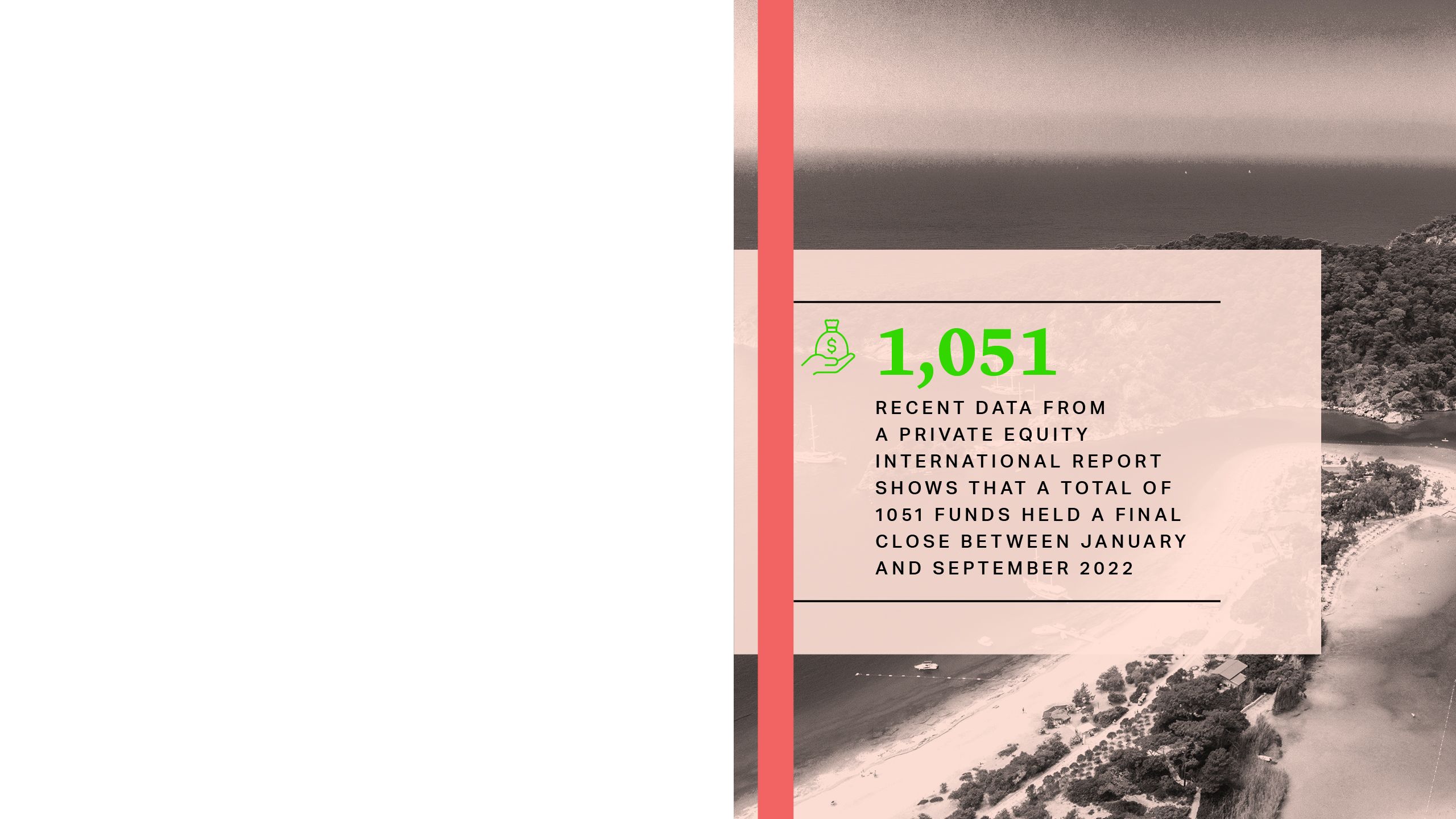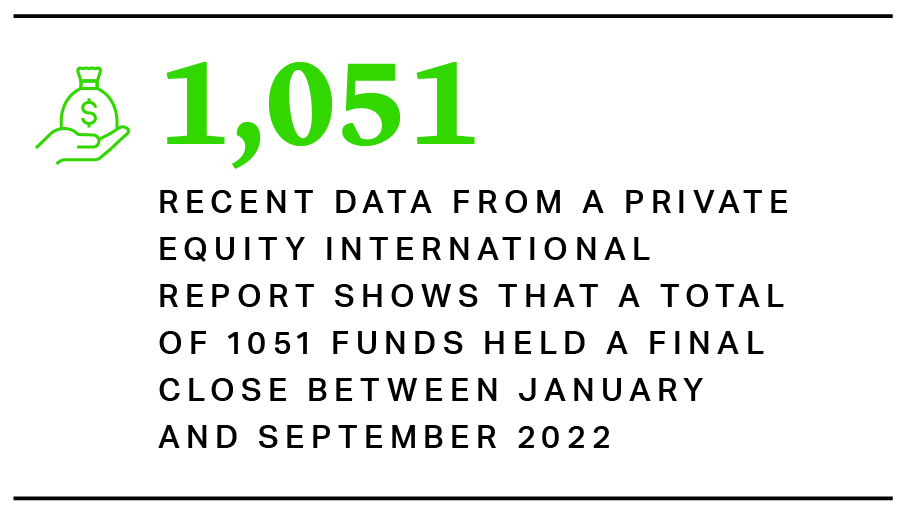Holding On: The Growing Benefits of Evergreen Fund Structures in Private Capital

Four decades after the beginning of the modern private capital age, most private funds still conform to the traditional 8- to 10-year closed-end structure. Yet, alternative investments have grown and evolved, and such investments are running up against end of fund lifecycles more and more frequently. And no sooner has one fund closed, than managers find themselves out on the road once more to raise capital for successor funds or adjacent strategies. In a changing private capital landscape, a large number of firms are considering hybrid or “evergreen” fund products to avoid the pressure to sell investments too early, allow access to a greater range of long-term investment strategies and sidestep competitive fundraising markets.
Dealing With Longer Holding Periods and Competitive Fundraising Markets
Average holding periods for private equity portfolio companies are now just under five years, with the most recent figures showing an average of 4.9 years in 20211. In 2022, U.S. private equity exit activity dropped consecutively for the first three quarters, indicating that holding periods will continue to grow2. In part, this reflects the shift in sponsor investment approaches. Instead of buying companies to fix and resell quickly, many firms are investing in long-term growth prospects. It also reflects an environment of market turbulence, where sponsors are biding their time for better exit opportunities.

Over the last five years, a number of large private equity firms have launched buyout funds with longer term holding periods. In 2017, Blackstone raised $5bn for a longer-life fund with expected holding periods of nearly double those of traditional buyout funds3.
Such extended holding periods in private equity are now being mirrored by private credit sponsors seeking the flexibility to provide consistent and longer-term financing to their underlying portfolio investments.

Dealing With Longer Holding Periods and Competitive Fundraising Markets
Average holding periods for private equity portfolio companies are now just under five years, with the most recent figures showing an average of 4.9 years in 20211. In 2022, U.S. private equity exit activity dropped consecutively for the first three quarters, indicating that holding periods will continue to grow2. In part, this reflects the shift in sponsor investment approaches. Instead of buying companies to fix and resell quickly, many firms are investing in long-term growth prospects. It also reflects an environment of market turbulence, where sponsors are biding their time for better exit opportunities.

Over the last five years, a number of large private equity firms have launched buyout funds with longer term holding periods. In 2017, Blackstone raised $5bn for a longer-life fund with expected holding periods of nearly double those of traditional buyout funds3.
Such extended holding periods in private equity are now being mirrored by private credit sponsors seeking the flexibility to provide consistent and longer-term financing to their underlying portfolio investments.

Holding investments for the long term often involves selling assets from one fund to a successor fund, raising conflicts of interest issues around valuations and carried interest payments. More recently sponsors have been creating continuation funds – via GP-led secondary transactions – for LPs to invest or re-invest in a new vehicle to hold one or more assets from a fund reaching the end of its lifespan.
Data from Jeffries financial group shows that continuation funds accounted for 80% of all GP-led transaction volume in the first half of 20224. This included KKR’s formation of a continuation fund for its investment in Internet Brands, in a deal valued between $2 and $2.5 billion5. GP-led deals can present complexities and costs for sponsors and investors, with the need for renewed due diligence and fairness opinions to set transparent and accurate pricing for the assets.
In some cases, firms are pre-empting the end of fund lifespans and seeking capital for further growth opportunities, in others they are seeking to prolong holds after reaching the limit of fund extension periods in order to maximize returns to investors.
The expectation of growth in secondaries activity is spilling into credit markets as established firms raise new pools of capital to serve exponential growth in the private debt space. Last year, Coller Capital announced that it expected to gather $1.4bn for its debut credit secondaries fund, underlining investor appetite for a wider range of private market secondaries strategies. While many private debt funds and institutional investors expect to hold loans to maturity, often periods of up to seven years, there is also growing demand for flexibility and liquidity options.
At the same time as they are creating structures to extend and manage investment holdings, GPs and LPs are facing more frequent fundraising cycles. Having reached its final close on its ninth fund in late April 20216, just eight months later EQT publicly kicked off the process for its successor by announcing a target of €20bn in January 20227. In practice, sponsors can find themselves in a near-constant fundraising mode targeting the same investor base as their competitors, which can also coincide with highly competitive or volatile markets.
Evergreen funds are an attractive proposition for GPs seeking longer-term capital and can have benefits for LPs who are less exposed to calls to re-up or the pressures of accelerated due diligence processes.
Holding investments for the long term often involves selling assets from one fund to a successor fund, raising conflicts of interest issues around valuations and carried interest payments. More recently sponsors have been creating continuation funds – via GP-led secondary transactions – for LPs to invest or re-invest in a new vehicle to hold one or more assets from a fund reaching the end of its lifespan.
Data from Jeffries financial group shows that continuation funds accounted for 80% of all GP-led transaction volume in the first half of 20224. This included KKR’s formation of a continuation fund for its investment in Internet Brands, in a deal valued between $2 and $2.5 billion5. GP-led deals can present complexities and costs for sponsors and investors, with the need for renewed due diligence and fairness opinions to set transparent and accurate pricing for the assets.
In some cases, firms are pre-empting the end of fund lifespans and seeking capital for further growth opportunities, in others they are seeking to prolong holds after reaching the limit of fund extension periods in order to maximize returns to investors.

The expectation of growth in secondaries activity is spilling into credit markets as established firms raise new pools of capital to serve exponential growth in the private debt space. Last year, Coller Capital announced that it expected to gather $1.4bn for its debut credit secondaries fund, underlining investor appetite for a wider range of private market secondaries strategies. While many private debt funds and institutional investors expect to hold loans to maturity, often periods of up to seven years, there is also growing demand for flexibility and liquidity options.
At the same time as they are creating structures to extend and manage investment holdings, GPs and LPs are facing more frequent fundraising cycles. Having reached its final close on its ninth fund in late April 20216, just eight months later EQT publicly kicked off the process for its successor by announcing a target of €20bn in January 20227. In practice, sponsors can find themselves in a near-constant fundraising mode targeting the same investor base as their competitors, which can also coincide with highly competitive or volatile markets.
Evergreen funds are an attractive proposition for GPs seeking longer-term capital and can have benefits for LPs who are less exposed to calls to re-up or the pressures of accelerated due diligence processes.

$1.4bn
Coller Capital recently announced that it expected to gather $1.4bn for its debut credit secondaries fund, underlining investor appetite for a wider range of private market secondaries strategies.

Evergreen Private Funds in a Nutshell
There is no one-size-fits-all approach to longer-term funds. Options range from ultra-long-term vehicles with a focus on “core” private equity assets that might aim to deliver low-double-digit IRRs over ten years or more, to evergreen vehicles that seek ultimate flexibility across asset types and holding periods, and hybrid options in between.
Evergreen funds raise an initial pool of capital from investors. However, instead of defining a fund lifespan and investment and divestment periods, the fund is designed to hold onto investor capital until an investor elects to redeem its interest or terminate its investment period. This allows fund managers to make and realize investments within the timeframes that the managers believe will maximize returns, at which point capital can be recycled into new investments or returned to limited partners.
Investors are given the opportunity to exit at certain times and under certain conditions, harvesting returns based on gains and net asset values of investments still held in the fund. Similarly, they can re-up or new investors can enter at specific points in time and at agreed valuations. Meanwhile, managers receive incentive compensation based on realized and sometimes unrealized returns from investments, usually determined annually or at the time of the disposition of a particular asset.
Some private sponsors have long employed evergreen funds, including General Atlantic and Golden Gate Capital, both firms with a focus on growth investments that might have longer holding periods. Sixth Street TAO, one of the largest private capital platforms globally, uses an evergreen model to invest across the capital structure into medium and long-term investments that might not fit into other private markets strategies. The firm is reported to have a “waiting list” of investors wanting to commit to its $25bn flagship vehicle8.
More firms, such as Blackstone, the Carlyle Group and KKR, have begun to establish long-term funds or hybrid vehicles that have much longer lifespans. In late 2020, Blackstone raised $8.2bn for its second core private equity fund, a long-hold strategy with a 20-year investment view9. Around the same time, Abu Dhabi investment fund Mubadala took a stake in technology-focused firm Silver Lake and invested a further $2bn in a new vehicle with a 25-year lifespan.
Many are also tapping into growth in investor appetite – at the institutional as well as retail level – for long-term investments that can ride out growing volatility and the impact of inflation on shorter-term investment markets. Following the development of its open-ended private credit vehicle in the U.S., Blackstone received approval from regulators for a similar structure in Europe that could offer perpetual private credit investments to European high-net-worths10.
It is not only firms making large investments that are focusing on perpetual capital. In 2021, U.S. VC Sequoia Capital established an evergreen fund to help it hold stakes in investment companies after they have gone public.
Evergreen funds raise an initial pool of capital from investors. However, instead of defining a fund lifespan and investment and divestment periods, the fund is designed to hold onto investor capital until an investor elects to redeem its interest or terminate its investment period. This allows fund managers to make and realize investments within the timeframes that the managers believe will maximize returns, at which point capital can be recycled into new investments or returned to limited partners.
Investors are given the opportunity to exit at certain times and under certain conditions, harvesting returns based on gains and net asset values of investments still held in the fund. Similarly, they can re-up or new investors can enter at specific points in time and at agreed valuations. Meanwhile, managers receive incentive compensation based on realized and sometimes unrealized returns from investments, usually determined annually or at the time of the disposition of a particular asset.
Some private sponsors have long employed evergreen funds, including General Atlantic and Golden Gate Capital, both firms with a focus on growth investments that might have longer holding periods. Sixth Street TAO, one of the largest private capital platforms globally, uses an evergreen model to invest across the capital structure into medium and long-term investments that might not fit into other private markets strategies. The firm is reported to have a “waiting list” of investors wanting to commit to its $25bn flagship vehicle8.
More firms, such as Blackstone, the Carlyle Group and KKR, have begun to establish long-term funds or hybrid vehicles that have much longer lifespans. In late 2020, Blackstone raised $8.2bn for its second core private equity fund, a long-hold strategy with a 20-year investment view9. Around the same time, Abu Dhabi investment fund Mubadala took a stake in technology-focused firm Silver Lake and invested a further $2bn in a new vehicle with a 25-year lifespan.
Many are also tapping into growth in investor appetite – at the institutional as well as retail level – for long-term investments that can ride out growing volatility and the impact of inflation on shorter-term investment markets. Following the development of its open-ended private credit vehicle in the U.S., Blackstone received approval from regulators for a similar structure in Europe that could offer perpetual private credit investments to European high-net-worths10.
It is not only firms making large investments that are focusing on perpetual capital. In 2021, U.S. VC Sequoia Capital established an evergreen fund to help it hold stakes in investment companies after they have gone public.

$8.2bn
In late 2020, Blackstone raised $8.2bn for its second core private equity fund, with a long hold strategy that included a 20-year investment view.

Benefits for Investors
Evergreen funds can also meet evolving investor needs. Recent data from a Private Equity International report shows that a total of 1,051 funds held a final close between January and September 202211. The rise in funds returning to the market, as well as funds from new GPs, is putting pressure on LPs to conduct more due diligence within tighter timeframes. Evergreen funds allow investors to make a commitment which they can periodically review and increase or decrease using the fund’s in-built liquidity and recycling options.
Hybrid evergreen funds that allow investors to redeem their interests can also be more efficient from a capital allocation and returns standpoint. Once the initial capital has been invested, these evergreen funds stay largely fully invested with a liquidity sleeve to ensure capital is available for new deals. In contrast, capital commitments to traditional closed-end funds can remain uncalled for several years, during which time they do not earn returns (but often still incur fees), while capital harvested from early exits is unlikely to be recycled into new investments. Partners Group has calculated that internal rates of return from closed-end fund strategies would need to be 20% to match an 11% return from an open-ended evergreen private equity program12.
For investors with a long-term view, evergreen funds may also provide even more alignment with GPs and could reduce some of the fees typically associated with exiting investments via sales and public offerings.

Benefits for Investors
Evergreen funds can also meet evolving investor needs. Recent data from a Private Equity International report shows that a total of 1,051 funds held a final close between January and September 202211. The rise in funds returning to the market, as well as funds from new GPs, is putting pressure on LPs to conduct more due diligence within tighter timeframes. Evergreen funds allow investors to make a commitment which they can periodically review and increase or decrease using the fund’s in-built liquidity and recycling options.

Hybrid evergreen funds that allow investors to redeem their interests can also be more efficient from a capital allocation and returns standpoint. Once the initial capital has been invested, these evergreen funds stay largely fully invested with a liquidity sleeve to ensure capital is available for new deals. In contrast, capital commitments to traditional closed-end funds can remain uncalled for several years, during which time they do not earn returns (but often still incur fees), while capital harvested from early exits is unlikely to be recycled into new investments. Partners Group has calculated that internal rates of return from closed-end fund strategies would need to be 20% to match an 11% return from an open-ended evergreen private equity program12.
For investors with a long-term view, evergreen funds may also provide even more alignment with GPs and could reduce some of the fees typically associated with exiting investments via sales and public offerings.
Conclusion
Evergreen funds or perpetual capital vehicles are not without their challenges for GPs and investors. Indeed, private capital sponsors need to be watchful for potential issues that might arise from new investors entering the fund, and from granting liquidity and exits to existing investors. Rigorous valuation approaches and structures are also required to ensure that managers and investors are aligning over carried interest incentives. However, with private sponsors and their investors seeing the benefits of holding onto key investments for longer, while avoiding the pressure of increasingly congested fundraising markets, evergreen funds can be an attractive solution for sponsors and investors. We expect this space to grow as the industry looks for ways to complement closed-end fund programs and address the cyclicality of private markets.
Elizabeth Lenas
Partner
New York
T: +1 212 225 2612
elenas@cgsh.com
V-Card
Maurice R. Gindi
Partner
New York
T: +1 212 225 2826
mgindi@cgsh.com
V-Card
Michael James
Partner
London
T: +44 20 7614 2219
mjames@cgsh.com
V-Card




